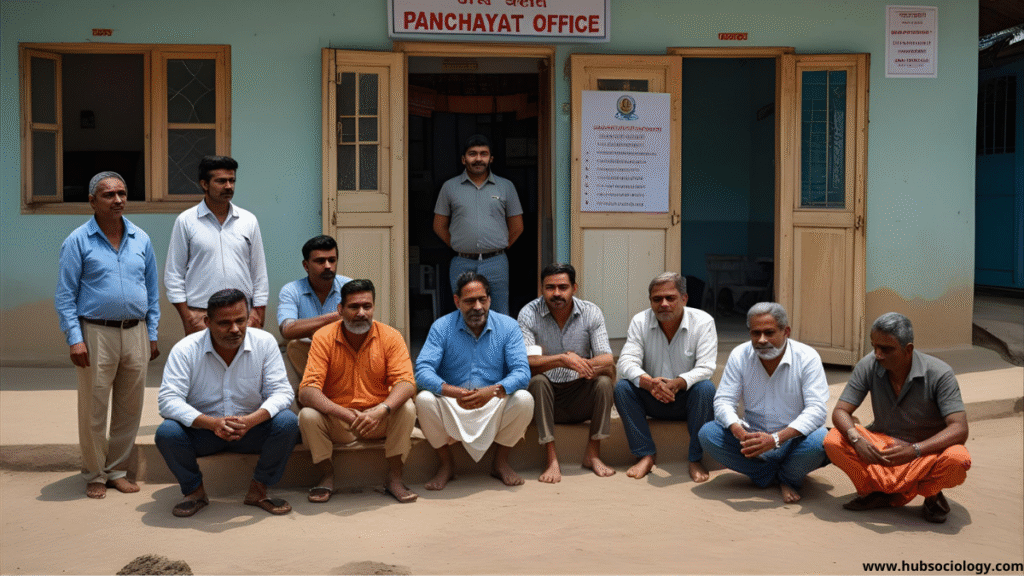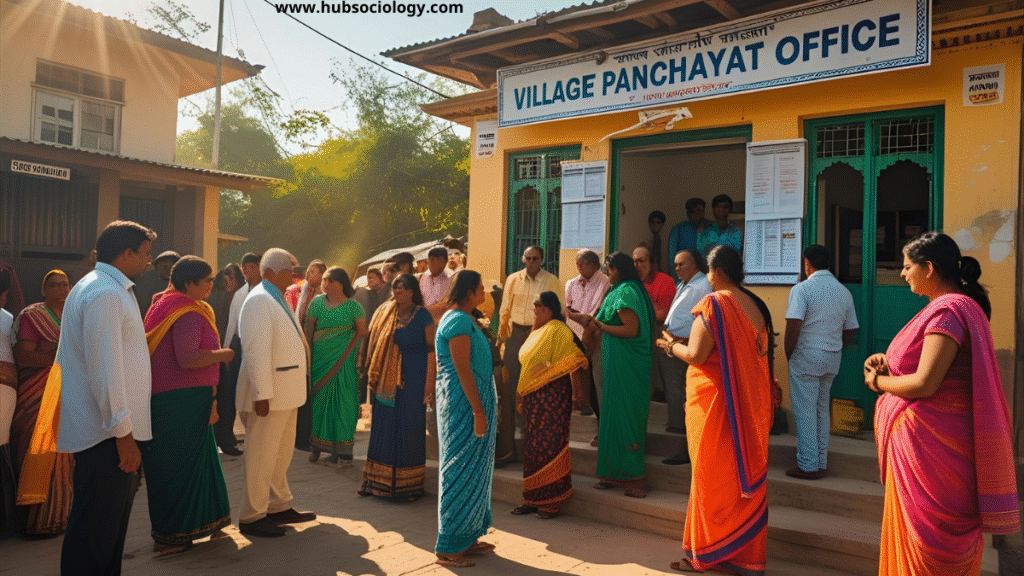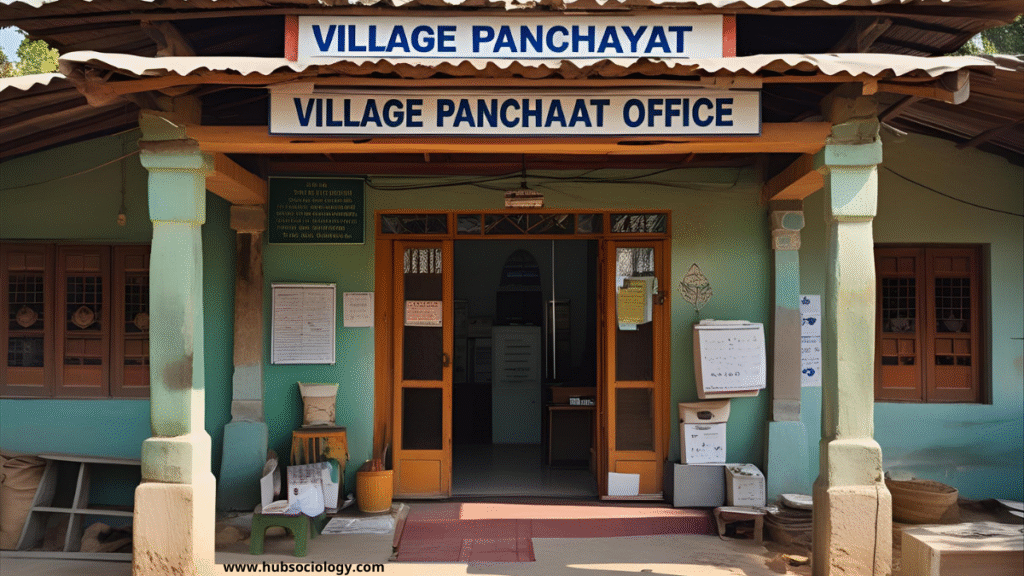Introduction on Panchayati Raj Institutions: 73rd Constitutional Amendment Act
The 73rd Constitutional Amendment Act of 1992 stands as one of the most radical pieces of legislation in the history of independent India. On the surface, it is a legal document that provided constitutional status to the Panchayati Raj Institutions (PRIs), mandating a three-tier system of local self-governance. However, to view it merely through a legal or administrative lens is to miss its profound sociological significance. The Amendment was, in essence, an ambitious state-sponsored project of social engineering, designed to dismantle centuries-old hierarchies and reconfigure power, agency, and identity in the heart of rural India. It sought to transform the gram sabha (village assembly) from a traditional, often exclusionary, body into a democratic arena for deliberation, redistribution, and social justice.
This article delves into the sociological aspects of the 73rd Amendment, exploring how it aimed to, and in many ways did, alter the social fabric of rural India, while also confronting the resilient structures of caste, class, and patriarchy.

Table of Contents
From Paternalism to Participatory Democracy: A Paradigm Shift
Prior to the 73rd Amendment, the Panchayati Raj system, though existing in various forms since the 1950s, was largely ineffective and operated at the mercy of state governments. It was often characterized by a top-down, paternalistic approach to development. The village elite, typically dominated by upper-caste landowners, controlled the resources and decision-making processes, perpetuating existing inequalities.
The 73rd Amendment introduced a paradigm shift from this paternalism to a model of participatory democracy. By constitutionally mandating regular elections, devolving funds, functions, and functionaries (the 3 Fs), and, most crucially, instituting reservations, the Act attempted to create an institutional framework for inclusive governance. This was not just about administrative efficiency; it was about recognizing the village as a site of political struggle and seeking to empower those historically denied a voice.
The Sociology of Reservations: Disrupting the Old Social Order
The most revolutionary sociological feature of the Amendment is the provision for mandatory reservations.
1. For Scheduled Castes (SCs) and Scheduled Tribes (STs): The reservation of seats and chairperson positions in proportion to their population was a direct assault on the caste-based monopoly of power. For the first time, it guaranteed a formal space for Dalits and Adivasis in the structures of local governance. This had several profound effects:
- Political Socialization: It forced the traditionally dominant castes to engage, albeit often reluctantly, with Dalit and Adivasi representatives in official capacities. The Panchayat office, once an exclusive domain, became a space where a Dalit Sarpanch (village head) could chair meetings and sanction funds.
- Assertion of Dignity and Agency: The mere presence of elected representatives from marginalized communities challenged the ingrained notions of ritual purity and pollution. It became a symbol of changed status and a source of collective dignity. As sociologist Anand Teltumbde notes, it provided a platform for the community to articulate its needs—from demanding clean water to challenging discriminatory practices.
- Confronting ‘Shadow Institutions’: However, this formal inclusion often clashed with the informal “shadow institutions” of caste. The phenomenon of Sarpanch-Pati or Proxy Sarpanch, where the elected female Sarpanch’s husband or male relative wields actual power, is a stark example of how old power structures subvert new legal ones. Upper-caste backlash, violence, and social boycotts against assertive Dalit Sarpanchs have been documented, revealing the limits of law in immediately eroding deep-seated social prejudices.
2. For Women (One-Third Reservation): This was arguably the most gender-progressive policy in India’s history. By reserving no less than one-third of all seats and chairperson positions for women, the Amendment triggered an unprecedented entry of women into the political sphere.
- From the Private to the Public Sphere: It forcibly pulled women out of the confines of the domestic sphere (ghar) and placed them in the public, male-dominated arena of politics (bahar). This challenged the patriarchal norms that confined women’s roles to hearth and home.
- The ‘Critical Mass’ Effect: The reservation created a critical mass of women representatives, leading to a shift in the political discourse. Panchayat meetings began to address “women’s issues” like drinking water, sanitation, childcare, domestic violence, and liquor prohibition—issues previously ignored as non-political or trivial.
- The Agency vs. Tokenism Debate: Sociologists have observed a complex reality. While many women have become confident leaders in their own right (a phenomenon often called the “second generation” effect where initial token representatives pave the way for more autonomous successors), many others remain rubber stamps for male relatives. Their effectiveness is often mediated by their caste, class, and educational background. Yet, even as tokens, their presence normalizes the idea of women in power for future generations.

The Gram Sabha: An Arena for Deliberative Democracy and Social Conflict
The Amendment envisioned the Gram Sabha as the cornerstone of democracy, a forum for direct participation where all adult villagers could exercise sovereignty. Sociologically, this transformed the village from a mere unit of administration into a political community.
It became an arena where development plans were to be formulated, beneficiaries selected, and accounts scrutinized. This open forum had the potential to break the clientelist networks controlled by local elites and bureaucrats. It allowed for the airing of grievances and fostered a culture of accountability. However, in practice, these spaces are often captured by dominant groups. The marginalized, despite their legal right to speak, may remain silent due to fear, social pressure, or lack of information, illustrating the gap between formal rights and substantive participation.
Changing Social Capital and Power Dynamics
The operation of Panchayati Raj Institutions has led to a reconfiguration of social capital in villages.
- Bridging vs. Bonding Social Capital: Traditional village society was strong in “bonding social capital”—ties within a homogeneous group (e.g., within a caste). The new Panchayati Raj system, in theory, promotes “bridging social capital”—connections of trust and reciprocity across different social groups (e.g., between castes, between men and women in a public meeting). Successful PRIs have fostered such bridges, leading to more collaborative development.
- New Elites and Fractured Dominance: The policy of reservations has created a new class of political elites from among the SCs, STs, and women. This has fractured the monolithic dominance of the traditional upper-caste elite, leading to a more competitive and pluralistic political field. However, this also leads to new tensions and conflicts as old elites resist their loss of privilege.
Persistent Challenges: The Sociological Limits of Law
Despite its transformative intent, the 73rd Amendment has run up against the stubborn realities of Indian society.
- Elite Capture and Corruption: The devolution of significant funds has made Panchayati Raj Institutions lucrative targets. Dominant groups often find new ways to capture these institutions, either by fielding proxies from within reserved categories or by co-opting elected representatives through bribes or threats.
- Lack of Genuine Devolution: Many state governments have been reluctant to devolve real power, functions, and financial autonomy to Panchayati Raj Institutions. This has kept them financially dependent and administratively weak, reducing them to implementing agencies for state and central schemes rather than self-governing bodies.
- The Deep Structures of Inequality: Law can mandate representation, but it cannot instantly erase centuries of social and economic inequality. Lack of education, economic dependence, and pervasive social discrimination continue to hinder the effective participation of marginalized representatives, limiting their ability to translate formal power into transformative action.
Conclusion: An Unfinished Social Revolution
The 73rd Constitutional Amendment Act was a watershed moment that initiated a silent, ongoing social revolution in rural India. Sociologically, its greatest achievement has been the politicization of identity and the legitimization of the marginalized. It has brought the struggle for social justice from the peripheries to the very center of local governance. It has made caste, gender, and tribe visible in the political process in an unprecedented way, forcing Indian democracy to confront its own deepest contradictions.

While it has not eradicated casteism or patriarchy, it has undoubtedly cracked their edifice of power. It has created a generation of leaders from sections of society that had never imagined holding office. The village chaupal (public sitting area) is no longer the exclusive preserve of a few; it is now a contested, dynamic, and more representative space. The journey from symbolic representation to substantive empowerment remains long and fraught, but the 73rd Amendment has provided the map and the vehicle for this journey. It remains the most potent institutional experiment in India’s quest to build a democracy that is not just of the people, but truly by and for all its people.
Do you like this this Article ? You Can follow as on :-
Facebook – https://www.facebook.com/hubsociology
Whatsapp Channel – https://whatsapp.com/channel/0029Vb6D8vGKWEKpJpu5QP0O
Gmail – hubsociology@gmail.com
Topic Related Questions on Panchayati Raj Institutions
5 Marks Questions on Panchayati Raj Institutions (Short Answer)
- List five key sociological objectives of the 73rd Constitutional Amendment Act.
- How did the 73rd Amendment change the traditional power structure in Indian villages?
- What is meant by the ‘elite capture’ of Panchayati Raj Institutions?
- Define the terms ‘bonding social capital’ and ‘bridging social capital’ in the context of Panchayati Raj.
- Briefly explain the concept of the ‘Gram Sabha’ as an arena for deliberative democracy.
- What is the sociological significance of reserving seats for women in Panchayati Raj Institutions?
- How has the 73rd Amendment impacted the political socialization of Scheduled Castes?
- Explain the term ‘Proxy Sarpanch’ or ‘Sarpanch-Pati’.
- What is the difference between formal and substantive participation in Panchayati Raj Institutions?
- Name two sociological challenges faced by women Sarpanchs in rural India.
10 Marks Questions on Panchayati Raj Institutions (Detailed Answer)
- “The 73rd Amendment was more than an administrative reform; it was an experiment in social engineering.” Discuss.
- Analyze the impact of political reservations for women on the patriarchal structure of rural Indian society.
- Examine the role of the 73rd Amendment in the political socialization of Scheduled Castes and Scheduled Tribes.
- How has the 73rd Amendment fostered the development of ‘bridging social capital’? Explain with examples.
- “The Gram Sabha is the cornerstone of the Panchayati Raj system.” Critically evaluate this statement from a sociological viewpoint.
- Discuss the phenomenon of ‘elite capture’ and its consequences for the democratic functioning of PRIs.
- How do pre-existing social hierarchies of caste and class influence the functioning of the newly empowered representatives in PRIs?
- Has the 73rd Amendment been successful in transforming the Panchayat from an exclusive body to an inclusive one? Argue your case.
- From a sociological perspective, differentiate between the ‘politics of presence’ and the ‘politics of influence’ in the context of PRIs.
- Critically assess the statement: “Reservations have created a new class of political elites from among the marginalized sections.”
15 Marks Questions on Panchayati Raj Institutions (Essay-type Answer)
- The 73rd Constitutional Amendment Act initiated a ‘silent social revolution’ in rural India. Critically examine this statement by analyzing its successes and limitations.
- From a sociological perspective, analyze how the provisions of the 73rd Amendment have intersected with the pre-existing realities of caste, class, and gender in rural India. Has the law been able to subvert these hierarchies?
- Evaluate the 73rd Amendment Act as a tool for achieving inclusive governance and social justice. What are the structural and sociological bottlenecks that impede its full realization?
- “The journey from symbolic representation to substantive empowerment remains long.” Discuss this statement in the light of the working of the Panchayati Raj Institutions after the 73rd Amendment.
- Write a critical essay on the changing nature of social power and authority in rural India after the implementation of the 73rd Constitutional Amendment Act.
